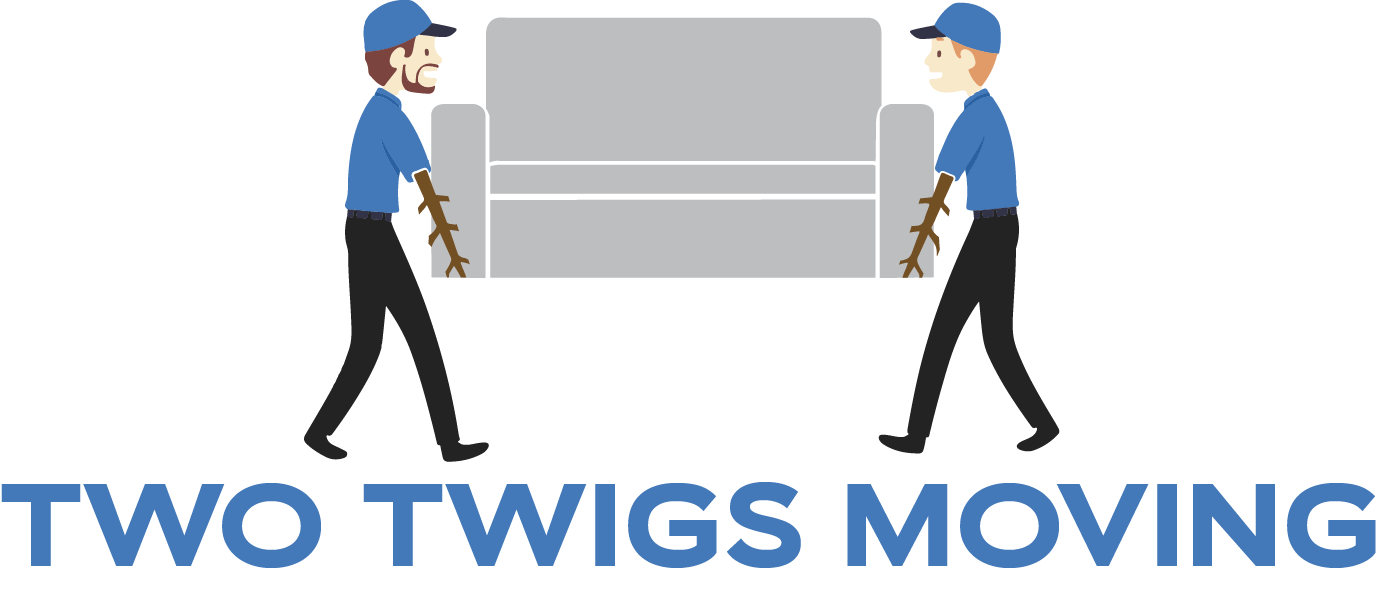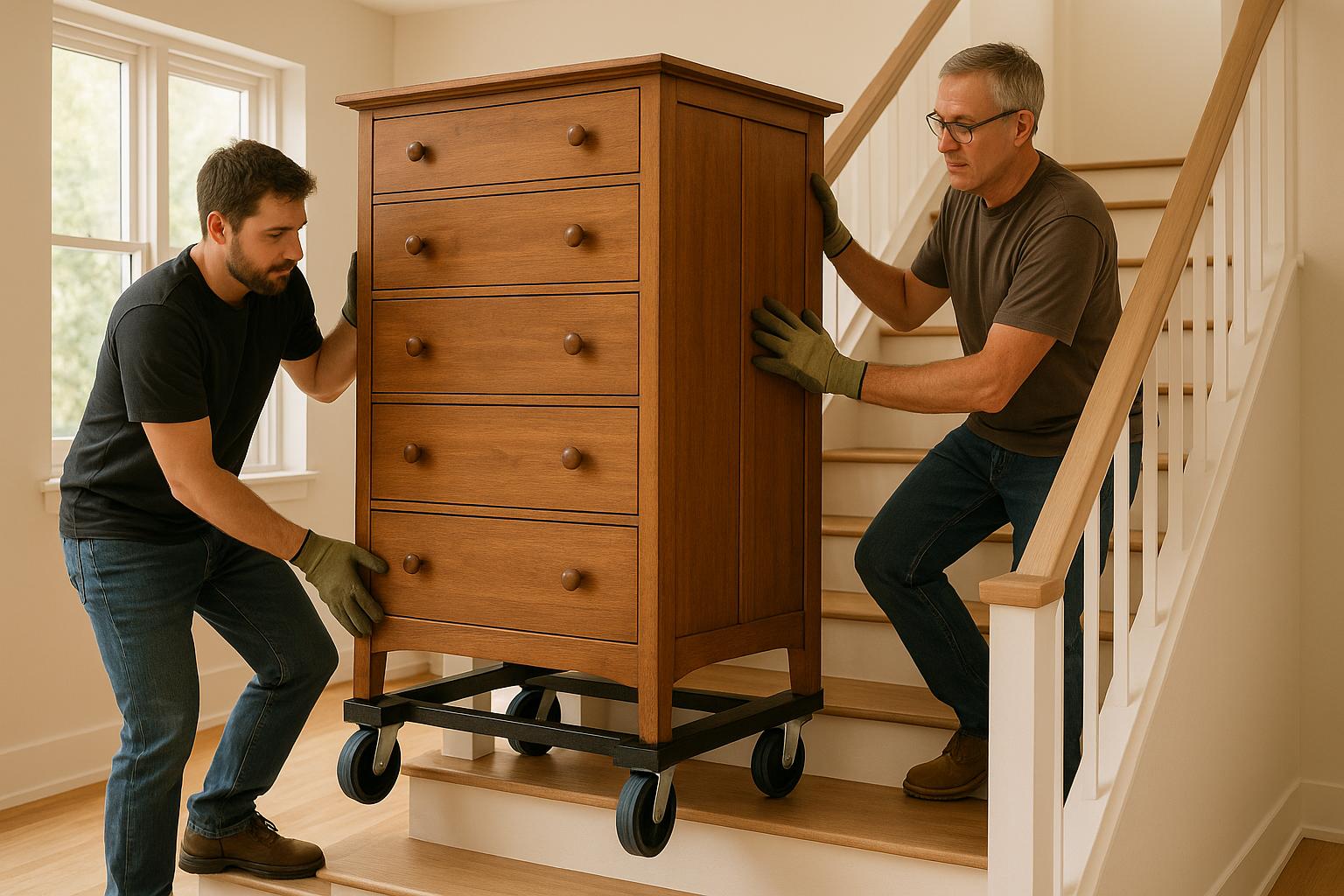Moving heavy furniture upstairs can be risky without proper planning and tools. Poor techniques lead to injuries, damaged property, and added costs. To ensure safety and efficiency, follow these steps:
- Plan Ahead: Measure furniture and stair dimensions, clear pathways, and remove obstacles.
- Use Proper Tools: Invest in furniture dollies, lifting straps, and protective padding to ease the process and prevent damage.
- Lift Safely: Use your legs, not your back, and avoid twisting your body. Work with a team for better control and communication.
- Protect Your Space: Cover walls, railings, and floors to prevent scratches or dents.
- Know Your Limits: For oversized or fragile items, consider hiring professional movers equipped with specialized tools and expertise.
Prioritize safety over speed and prepare thoroughly to avoid accidents or damage. If the task feels overwhelming, professional help is a smart choice for a smoother move.
Planning and Preparation
When it comes to moving furniture, success often hinges on what happens before the first piece is lifted. Careful planning helps you anticipate potential challenges and ensures you have the right tools for a safe and efficient move.
Measure and Check Fit
Start by measuring your furniture and all access points – doorways, hallways, and stairs – to ensure everything will fit. Standard doorways typically measure 30-36 inches wide, but older homes or apartments may have narrower openings that can complicate things.
For stairways, take note of each segment’s dimensions, including ceiling height at both the top and bottom steps, as well as the width and depth of landings. Don’t forget to account for handrails or banisters that might limit space. Pay special attention to the diagonal measurement from the steps to the landing, as this will determine whether you’ll need to tilt furniture at certain angles to maneuver it.
Leave an extra 1-2 inches of clearance when comparing measurements to avoid tight squeezes. For items like sofas and chairs, ensure the width of the entryway exceeds the piece’s depth, diagonal depth, or height so it can pass through without damage. If space is especially tight, removing door hinges can provide a few more inches of clearance.
Document these measurements and snap photos of tricky spots with your phone. Having this information handy will make it easier to plan a safe and efficient route.
Clear the Path
Before moving day, clear all obstacles from your path. This includes rugs, small furniture, and decorations on stairs or in narrow spaces. Wall hangings and fragile items should also be removed to prevent accidents. Check stairways for loose railings or other hazards that could interfere with your movement.
Clean floors thoroughly by vacuuming or mopping to eliminate dirt or slippery areas that could cause a fall. If you’re moving furniture across multiple rooms or levels, map out your stops, turns, and breaks beforehand to stay organized. Once your measurements and routes are confirmed, it’s time to gather the right tools.
Get the Right Equipment
Invest in or rent essential moving tools like furniture dollies, moving straps, protective padding, and work gloves. Moving straps are especially useful for navigating stairs and uneven surfaces, as they help distribute weight more evenly and make heavy loads easier to manage. Renting a utility dolly costs about $7-$15 per day, while a furniture dolly runs $8-$15 per day from most moving companies or truck rental services.
Choose equipment based on the type of furniture you’re moving. Furniture dollies are ideal for large, heavy items, while strap systems like the Shoulder Dolly or Forearm Forklift distribute weight differently – shoulder straps rely on your shoulders and back, while forearm straps focus the load on your arms.
Don’t forget basic tools like screwdrivers, pliers, a hammer, and a measuring tape for disassembling furniture when necessary. Taking furniture apart before moving it can significantly cut down on weight and reduce the risk of damage, making the whole process smoother. With the right tools in hand, you’ll be ready to tackle the next steps of safe lifting and carrying.
Tools and Equipment You Need
Having the right tools can turn a potentially risky furniture move into a safer and smoother task. Statistics show that over 68% of moving-related injuries occur when people try to handle heavy furniture without proper equipment, and about 82% of furniture damage happens for the same reason. Thankfully, you don’t need a massive budget to equip yourself with the essentials that can make a huge difference in both safety and efficiency.
Furniture Dollies
Furniture dollies are a game-changer when it comes to moving heavy items. These wheeled platforms are perfect for getting bulky furniture to the base of a staircase and can even assist with stair navigation when paired with the right support. They help reduce physical strain and lower the chance of damaging both your furniture and your home.
Choosing the right dolly depends on what you’re moving. Utility dollies are great for smaller items and boxes, while large appliances often need specialized models. Keep in mind, though, that dollies are best suited for flat surfaces. For staircases, hand trucks with straps are a better option since they’re designed specifically for moving items up or down stairs.
When it comes to cost, basic furniture dollies start at about $20, mid-range options cost around $40, and heavy-duty models can go up to $60. If you’re not planning to use it often, renting might be more practical. Rentals typically cost $7–$10 per day for standard dollies, with heavy-duty ones priced up to $20. Hand trucks, on the other hand, range from $40 to $80 to buy or about $10 per day to rent.
For the best results, opt for industrial-grade dollies with durable, smooth-rolling casters. These will perform far better than cheaper, flimsy options. To further ease the process, consider adding lifting straps to your toolkit.
Lifting Straps
Lifting straps are a fantastic complement to dollies, especially when tackling stairs. These straps make heavy furniture feel significantly lighter – up to 66% lighter, according to some studies. They also help distribute weight evenly, reducing the risk of injuries.
One popular option is the Shoulder Dolly Moving Straps, which boast a 4.5/5 star rating on Amazon with over 25,000 reviews. Customers often highlight how these straps simplify moving large, awkward items and praise their sturdy construction.
To use lifting straps safely, keep your back straight and rely on your legs to do the heavy lifting. Proper body positioning is key to avoiding injuries. Additionally, these straps help stabilize furniture during transport, minimizing the risk of items shifting or falling as you navigate stairs.
When shopping for lifting straps, make sure they’re rated to handle the weight of your heaviest furniture. Their ability to make lifting easier can save you significant effort compared to traditional methods.
Protective Padding
While mechanical aids like dollies and straps handle the heavy lifting, protective padding ensures your furniture and home stay in good condition throughout the move. Moving blankets and other padding not only shield your furniture from scratches, dents, and scuffs but also protect walls and doorways – especially in tight stairwells where accidental bumps are common.
Furniture blankets are your first line of defense. Wrap your items completely in these thick, soft covers and secure them with plastic wrap or tape. For delicate or oddly shaped pieces, bubble wrap provides extra protection when taped securely in place.
Don’t forget to protect your walls, too. In narrow hallways or staircases, cover walls with blankets or cardboard to prevent scrapes and dings. Old bedsheets or drop cloths can also work in a pinch, while corner guards offer extra protection for wall edges. For high-traffic moving paths, metal wall protectors are a sturdier option compared to vinyl.
Safe Lifting and Carrying Methods
Using proper lifting techniques not only helps prevent injuries but also gives you better control when handling heavy furniture. Back in 2001, over 36% of work-related injuries that led to missed days were linked to shoulder and back issues – often caused by bending, twisting, and turning incorrectly. Taking just a few moments to plan how you’ll lift, carry, and set down heavy items like dressers or couches can make all the difference.
Lift with Your Legs
Your legs are your strongest asset when it comes to lifting. Start by positioning yourself close to the furniture, with your feet shoulder-width apart for balance. Bend your knees – never your back – and keep your arms and elbows tucked close to your body. If gripping the item feels tricky, consider using lifting straps for extra support.
As you squat, engage your core and keep your back straight. Use the strength in your hips and knees to lift the item slowly, keeping it within your "power zone" – the area between your mid-thigh and mid-chest. When it’s time to set the item down, simply reverse the process. This method helps you stay in control and minimizes strain. These steps also set the stage for effective teamwork when lifting with others.
Work as a Team
Teamwork is critical when moving heavy furniture. Assign clear roles to each person involved. For example, one person can focus on lifting, another can guide through tight spaces, and a third can ensure the path is clear. Before you start, agree on verbal cues like "lift", "stop", "turn", or "set down" to keep everyone on the same page. Maintain open communication throughout the move, and take regular breaks to avoid fatigue. A coordinated team effort reduces the risk of accidents and keeps everyone safe.
Avoid Twisting Your Body
Even with proper lifting techniques and teamwork, twisting your body can put your back at serious risk. When you twist your spine during a lift, only about half of the fibers in the annular ring can resist the rotation, making your back more susceptible to injury. Combining lifting with twisting significantly raises the chances of musculoskeletal issues. This type of strain is a common cause of acute low back pain.
To avoid twisting, pivot your feet to change direction instead of rotating your torso. Keep your hips, shoulders, and knees aligned as you move. Take small, deliberate steps to reposition yourself, and always keep the furniture close to your body with your elbows tucked in. If you encounter a tight space, stop and adjust your position properly rather than forcing a twist.
"NEVER Lift and Twist – with shoveling, exercise or moving heavy objects" – Lori Duncan PT
sbb-itb-a5538b6
Stair Moving Techniques
Getting heavy furniture up a staircase is no small feat. The tight spaces, sharp angles, and constant pull of gravity make it a task that requires careful planning and smart techniques to avoid damage or injury.
Using a Dolly on Stairs
A stair-climbing dolly can be a lifesaver when dealing with heavy furniture. Unlike standard dollies, these are equipped with special wheels or tracks designed to navigate stairs more smoothly.
Here’s how to use one effectively:
- Load the furniture onto the dolly and secure it with sturdy straps.
- Plan your route in advance to identify potential obstacles and decide the best approach.
- When going upstairs, tilt the dolly toward you, position it on the first step, and pull upward while a helper steadies it from below. For descending, tilt the dolly toward your body and guide it step by step, with assistance from another person.
Communication with your helpers is key. Move slowly, and if the staircase has a small elevation change, consider using a ramp instead of bumping the dolly over each step.
If a dolly isn’t an option, sliding techniques can be a practical alternative.
Sliding Methods
Sliding can work well for furniture with smooth surfaces, especially if a dolly isn’t feasible. However, preparation is critical.
- Empty out furniture like dressers and cabinets by removing shelves, drawers, and other loose parts to lighten the load.
- Disassemble larger pieces when possible, and keep screws and hardware organized for reassembly.
- Place sliders or thick moving blankets underneath the furniture to reduce friction and protect surfaces.
Position the item at the base of the stairs, aligning it with the staircase before starting the slide. Enlist helpers – one person should guide from above while others stabilize the sides and bottom. Take breaks to adjust grips and assess your progress.
And don’t forget to protect your floors.
"Protect Your Floors: Use blankets, cardboard, or rugs to prevent scratches when sliding furniture." – North Bay Movers
Protecting Walls and Railings
Navigating heavy furniture through stairwells can easily lead to scuffed walls or damaged railings, so adding protective layers is a must.
- Wrap the furniture in moving blankets, securing them with tape or straps to cushion sharp corners.
- Cover walls in narrow spaces with blankets or cardboard, using painter’s tape to hold them in place.
- Pad corners with folded blankets, bubble wrap, or cardboard to prevent accidental bumps.
Railings need attention too. Wrap them in moving blankets and secure with rope or tape to shield them from scratches and dents. For stairs, protect carpeted steps with self-adhesive plastic film and use stair edge guards on hard surfaces. Secure any coverings with tape to prevent slipping or tripping hazards.
With the right tools, a solid plan, and a bit of teamwork, moving furniture up stairs becomes a manageable challenge rather than a daunting task.
When to Hire Professional Movers
Even with the best DIY moving techniques, there are times when it’s smarter – and safer – to call in the pros. Certain items, especially those that are heavy, fragile, or valuable (like pianos), demand expert handling to prevent damage or injury.
Heavy or Fragile Items
Some furniture and belongings are simply too risky to move on your own. Think of large, delicate, or pricey items like pianos. As moving expert Thomas Trainer puts it:
"Moving can require skill especially if the pieces are large or heavy. If you don’t have the skills or the strength to do it properly, it’s not worth damaging the piece, the residence or yourself."
The statistics back this up: 6.9 million workdays are lost each year due to musculoskeletal injuries. Many of these injuries could be avoided by relying on professionals who know how to handle such challenges. Movers bring the expertise to disassemble furniture, protect fragile surfaces, and navigate tight spaces like staircases – all while minimizing the risk of costly repairs or replacements.
Local Moving Services
Hiring professional movers can save you from the stress of packing, lifting, and arranging your belongings – especially when dealing with tricky layouts like narrow staircases. For those living in areas like Charlotte, Charleston, or Greenville, local moving companies provide tailored services for residential, apartment, or office moves. These services often include insurance coverage and contractual guarantees, giving you an extra layer of security. Plus, with their advanced tools and expertise, professional movers make the whole process far more efficient.
Professional Tools and Training
What sets professional movers apart is their access to specialized equipment and training. Using tools like stair-climbing dollies and lifting straps, they’re equipped to handle even the toughest moves. Their training includes techniques for coordinated lifting, proper weight distribution, and injury prevention. By carefully studying your home’s layout and planning the best routes, they ensure a smooth and secure move, no matter how complex the job may be.
Conclusion
Moving heavy furniture upstairs requires careful preparation, the right equipment, and teamwork. According to international guidelines, carrying loads over 55 pounds on stairs is discouraged. This underscores the importance of knowing your limits and recognizing when to ask for help.
Tackling such tasks alone can lead to serious risks, including muscle strain, back injuries, or accidents. That’s why teamwork is essential. Pairing this effort with proper lifting techniques and the right tools can make even the toughest moves more manageable.
For situations where the job feels too risky or beyond your capacity, hiring professionals is a smart choice. Whether you’re dealing with oversized, fragile pieces or simply don’t have the right equipment, a local moving company can ensure a smooth and safe process, saving you from potential injuries or damage.
Take the time to plan thoroughly, focus on safety over speed, and don’t hesitate to seek professional help when needed. Protecting your health and your possessions should always come first.
FAQs
What are some common mistakes to avoid when moving heavy furniture upstairs?
Moving heavy furniture upstairs is no small task, and it’s easy to make mistakes that could lead to injuries or damage. One common issue is lifting too quickly or incorrectly – like relying on your back instead of your legs. To stay safe, focus on proper technique: lift with your legs, keep your back straight, and take your time with steady, controlled movements.
The right tools can make all the difference. Items like hand trucks, furniture sliders, or straps can help stabilize heavy pieces and protect both the furniture and the stairs. And don’t forget the value of teamwork – having an extra set of hands can ease the strain and make the process much safer.
Finally, preparation is key. Measure doorways, staircases, and tight corners beforehand to ensure the furniture will fit. Clear the path of any obstacles to avoid accidents or delays. Planning ahead can save you a lot of headaches.
When is it safer to hire professional movers instead of moving heavy furniture on your own?
When it comes to moving heavy or oversized furniture, hiring professional movers is often the smarter and safer choice. If you don’t have the right tools, experience, or physical capability, trying to handle such items yourself can lead to injuries or even damage to your belongings. This becomes even more crucial if you’re recovering from an injury or dealing with fragile furniture that requires extra care.
Professional movers are skilled in heavy lifting and know how to minimize risks, whether it’s preventing accidents or avoiding property damage. They bring along specialized equipment like dollies and straps, making the process not only safer but also more efficient. If you’re uncertain about managing a move on your own, bringing in professionals can save you a lot of time, energy, and unnecessary stress.
What tools can help move heavy furniture up stairs safely, and where can I find them?
When tackling the challenge of moving heavy furniture up stairs, using the right tools can make all the difference. Equipment like electric stair climbers, stair-climbing dollies, or hydraulic lifters is specially designed to ease the effort and improve safety. These tools are available for purchase at hardware stores or online, and if you only need them temporarily, many retailers offer convenient rental options.


.svg)


